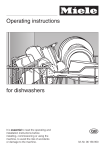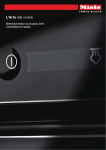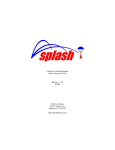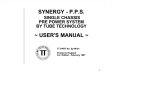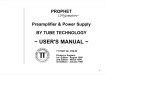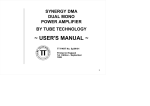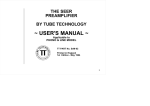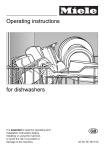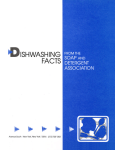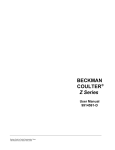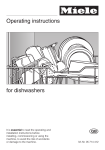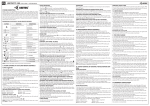Download Miele G 6XX Technical information
Transcript
Dishwasher Care and Maintenance General DTD no. 21-0000 Technical Information Dishwasher Care and Maintenance General - Table of Content 1.0 Notes ..............................................................................................................4 1.1 Dishwasher cleaning and care.................................................................4 2.0 Cleaning agents.............................................................................................5 2.1 Detergent.................................................................................................5 2.2 Rinse aid..................................................................................................6 2.3 Ractivation salt ........................................................................................7 2.4 Combination products (2 in 1, 3 in 1) Function ........................................8 2.5 Machine care products ..........................................................................10 2.6 Deodorant..............................................................................................12 2.7 Glass protection products ......................................................................12 3.0 Dishwasher load ..........................................................................................13 3.1 General information ...............................................................................13 3.2 Glass .....................................................................................................13 3.3 Silver .....................................................................................................17 3.4 Stainless steel .......................................................................................19 3.5 Aluminum, tin, copper and brass ...........................................................21 3.6 Ceramics ...............................................................................................21 3.7 Porcelain................................................................................................23 3.8 Wood .....................................................................................................24 3.9 Plastics ..................................................................................................24 3.10 Loading the dishwasher.........................................................................25 4.0 Wash technology.........................................................................................27 4.2 Programs ...............................................................................................28 4.3 Summary of wash and drying phases....................................................28 4.4 Drying ....................................................................................................29 4.5 Water softening and reactivation ...........................................................31 5.0 Fault Repair..................................................................................................33 5.1 Generally poor washing results .............................................................33 5.2 Grainy or sand-like residues ..................................................................35 5.3 Dull deposits ..........................................................................................36 5.4 Items not bright or shiny ........................................................................37 5.5 Tea or coffee stains ...............................................................................37 5.6 Lipstick stains ........................................................................................38 5.7 Spinach, cabbage or herb residues .......................................................38 5.8 Grease residues ....................................................................................38 5.10 Odor development .................................................................................40 5.11 Salt residues..........................................................................................41 5.12 Calcareous deposits in the cabinet........................................................42 2 Technical Information Dishwasher Care and Maintenance General - Table of Content (continued) 5.13 Residues in cabinet ...............................................................................42 5.14 Wearing out of rubber parts ...................................................................43 5.15 Powder detergent in dispenser clogged and not properly flushed out ...43 5.16 Dishes not properly dry..........................................................................44 3 Technical Information 1.0 Notes 1.1 Dishwasher cleaning and care General information 1. The filter combination must be emptied and cleaned regularly. 2. If wash results deteriorate noticeably, the spray arm jets should be checked and cleaned carefully to remove any soil that may have collected. 3. Provided the correct type and quantity of detergent is used and the unit operated correctly, dishwashers do not need any special care as the wash cabinet and baskets are largely self-cleaning during normal everyday use. However, if the appliance interior has become soiled due to incorrect program selection or insufficient detergent dispensing, a more effective program such as Intensive should be run using a suitable proprietary dishwasher cleaner. 4. To ensure problem-free operation of the unit, the water softener must be filled with reactivation salt using the funnel supplied whenever the Salt warning indicator lights up. Immediately following this, a short program such as Rinse & Hold should be operated without load. This is to remove any salt or brine residues that might be present in the cabinet, on the filters or in the sump and thus prevent possible corrosion. Alternatively a normal wash program can be started in the usual manner even if the machine is only partially loaded. 5. The rubber seals around the door should be cleaned regularly with a damp cloth to remove food residues. 4 Technical Information 2.0 Cleaning agents 2.1 Detergent Detergent is available in various forms such as powder, detergent tablets (tabs), gel/liquid or as part of a combination product. As well as detergent, combination products may also contain rinse aid (“2 in 1 tab”). In addition, “3 in 1 tabs” also contain a salt substitute. However, their use is only recommended with a water hardness of up to 21gr/gal. The majority of detergents available on the market today is provided in concentrated form and is mildly alkaline. Detergent must perform a number of varied tasks as follows: 1. Independently emulsify and disperse food residues: During this process detergent will encounter the most diverse residues from grease, fat, starch and denaturated protein to tea stains which will also be in various states, including dried-on and burnt-on, such as: a. Water-insoluble substances (e.g. oil, grease). b. Water-soluble substances (e.g. salt, sugar). c. Water-dispersible substances (e.g. starch, protein). d. Chemically indecomposable substances (e.g. sand). e. Chemically decomposable substances (e.g. tannin, lipstick residue). 2. Remove discoloration. 3. Prevent redepositing of food remains and starch or lime residues. 4. Bind lime and heavy metals. 5. Prevent corrosion. Chemical composition / Function of various components: 1. Alkalinity carrier (metasilicates): Dried-on food residues are swelled to ease removal, dishwasher load is protected against corrosion, alkalinity is provided. 2. Builder (phosphates): Binding of substances causing water hardness, removal of tea stains, dispersal of soil and food residues. 3. Bleaching agent (perborate): Removal of stains (tea, coffee, colored food residues), killing of Microorganisms. 5 Technical Information 2.2 Rinse aid Rinse aid is used to ensure that the load is dry, with a universal sheen and free of filming, streaking or stains at the end of the wash program. Depending on setting, between 2 and 6 ml rinse aid is used per wash. Rinse aid ensures optimal wetting of the load and at the same time leads to sheeting of the rinse water as it drains off. The better the water drains off, the better the drying of the load and the less the tendency for marks to remain on items. If rinse aid is not used, evaporation residues (dried on water drops) remain on the load because the softened water contains dissolved salt. Note Only rinse aid designed specifically for dishwashers may be used. Normal liquid detergent must not be used. Domestic vinegar with max. 5% acidic content or up to a 50% solution of citric acid can be used as alternatives but drying and rinsing results will be greatly impaired compared to those experienced with rinse aid. Vinegar with a higher acidic content (e.g. concentrated vinegar) must not be used as it may cause damage to the machine. Chemical composition / Function of various components 1. Wetting agent (non-ionic tensides): 2. To reduce the surface tension of the water. The load is thoroughly wetted and foam-free washing is ensured. 3. Solubilizer (alcohol, xylolsulphonate or cumolsulphonate): To ensure stability of the rinse aid by preventing the components separating out. 4. Organic acids (citric acid, fruit vinegar): To remove the residual hardness elements of the water and prevent deposits and possible transfer of alkaline residues in the suds. The storage and temperature stability of the rinse aid is increased and mold development is prevented. 5. Preservatives: To prevent mold development. 6. Fresheners: To give a pleasant odor. 6 Technical Information 2.3 Reactivation salt Some dishwashers are provided with a water softener, which must be filled regularly with reactivation salt to ensure efficient operation. For further information, see 4.5 Water softening and reactivation. Pure reactivation salt dissolves without residue. For this reason only special reactivation salt or pure evaporated salt may be used in the water softener. Other readily available salt such as cooking salt, de-icing salt and industrial salt must not be used as they have non-soluble components (e.g. pourability enhancers), which can adversely affect the function and capacity of the water softener. Note Even with the lowest water hardness level (hardness range 1), the salt container must be filled with reactivation salt as otherwise white residues may be left on the load. Warning! Inadvertently filling the water softener with detergent or combination products will damage the ion exchanger. If detergent is poured into the softener by mistake, do not start the machine. Proceed as follows: 1. Wear protective rubber gloves. Detergent may be corrosive. 2. Empty the salt container as much as possible using a small ladle or similar. 3. Flush out the salt container with a large quantity of fresh clean water. See also 4.5 Water softening and reactivation. 7 Technical Information 2.4 Combination products (2 in 1, 3 in 1) Function These products are a combination of detergent and rinse aid (2 in 1) or detergent, rinse aid and salt substitute (3 in 1) and are dispensed during the main wash step. The function of combination products is based on the fact that they dissolve in stages and do not lose their effectiveness when water is drained off. Their effectiveness is transferred from wash cycle to rinse cycles. This is known as the carry-over effect. However, the concentration is reduced from cycle to cycle. Note Previously there were combination products designed to dissolve depending on certain pH values or temperature. Note There are also 4 in 1 products on the market. In addition to detergent, rinse aid and salt substitute, they include a constituent for glass protection. Some manufacturers include a glass protector as an additive in the detergent but do not refer to this separately. The glass protector is automatically released during the wash cycle so no program modification is required. 4 in 1 tabs can be used in all Miele dishwashers with and without 3 in 1 function, without any adverse effects. Properties Under certain circumstances unsatisfactory cleaning or drying results can be due to the use of combination products. Tests in application technology laboratories have shown that the best cleaning or drying results are achieved by using a standard proprietary dishwashing detergent in conjunction with rinse aid dispensing and optimal water softening via a dedicated water softener. Under laboratory conditions, all combination products produce poorer results. Test institutes also recommend the use of powder dishwashing detergent or normal (non-combination) tabs, reactivation salt and rinse aid. 8 Technical Information If complaints are received concerning poor drying results when using combination products, these should be redirected to the detergent manufacturer. To achieve good cleaning and drying results, the following should be noted: 1. Combination detergent should only be used within the water hardness range given by the manufacturer! 2. Select programs without a second interim rinse, otherwise the carry-over effect cannot be ensured. 3. Position combination products in the machine in accordance with the manufacturer's instructions (e.g. in a combination product dispenser if recommended). If these instructions are not followed, the following may occur: 1. Poor drying results, see Dishes not properly dry, 5.16. 2. White deposits on the load and the cabinet. Note To counter problems of this type, machines from the model series G 1xxx or G2xxx have the following new features: To ensure optimal cleaning results, when the Tab function is selected, salt is still required for reactivation, but consumption is greatly reduced to between a quarter and third of normal requirements. In addition rinse aid is dispensed by a single pulse to empty the combination dispenser and thus prevent sticking. Chemical composition / Function of various components 1. Alkalinity carrier (soda, silicate): To swell dried-on residues, protect items in the load against corrosion and provide alkalinity. 2. Bleach (perborate in combination with bleach activator TAED): To remove stains (tea, coffee, colored food residues) and kill microorganisms. 9 Technical Information 3. Builder, co–builder and salt substitute (phosphates, polycarboxylates, phosphonates): To bind water hardness elements, remove tea stains and disperse soil and food residues. 4. Enzymes (biological constituents): Amylase breaks down starch residues. Protease splits protein molecules into smaller constituents, which can then be released by the suds. 5. Wetting agent (non-ionic tensides): To reduce the surface tension of the water. The load is thoroughly wetted and foam-free washing is ensured. 6. Fresheners and colorants: To give the machine a pleasant odor and appearance. 2.5 Machine care products A machine care product should act to remove residues such as grease and calcareous deposits in visible and non-visible areas of the water-carrying parts of the dishwasher. To achieve this result, the most powerful dishwashing program should be used. A machine care product can also be used to remove calcareous deposits from items in the dishwasher load and discoloration from stainless-steel surfaces as well as removing residues from around the door seal area. Note Machine care products must not be used in combination with detergent. Both products together would neutralize each other as the detergent works with alkalinity and machine care products with acidity. 10 Technical Information Chemical composition / Function of various components: 1. Wetting agent (non-ionic tensides): To reduce the surface tension of the water. The load is thoroughly wetted and foam-free washing is ensured. 2. Solubilizer (alcohol, xylolsulphonate or cumolsulphonate): To ensure stability of the rinse aid by preventing the components separating out. Rubber seals remain elastic. 3. Organic acids (citric acid, fruit vinegar): To remove calcareous deposits and other deposits that can be dissolved in acid. Also to remove tarnish from stainless-steel surfaces. The storage and temperature stability of the rinse aid is increased and mold development is prevented. 4. Fresheners: To give a pleasant odor. 11 Technical Information 2.6 Deodorant If dirty dishes are left in the dishwasher for a long period, unpleasant odors can develop quickly. A special deodorant to counter this can be hung in the interior. Such deodorant is generally effective for about 50 wash cycles. Note When positioning the deodorant, care must be taken to ensure that the spray arms are not hindered. 2.7 Glass protection products Additional products are available on the market to protect glass items against glass corrosion. During the wash cycle, depending on the intensity of possible glass corrosion, glass protection products are released continually and act to neutralize glass damaging substances. 12 Technical Information 3.0 Dishwasher load 3.1 General information The dishwasher load can be divided into two broad groups. 1. Items for food preparation: Aluminum, steel (pot, pans), oven-proof dishes (casserole dishes), etc. 2. Items for food consumption: Porcelain, glass, silver and stainless steel cutlery, etc. 3.2 Glass Glass with its many favorable properties (transparency, refraction, reflection, shine, water-imperviousness, taste- and odor-neutrality, chemical resistance) is a material frequently used in the home for equipment for food and drink preparation and consumption. From a chemical standpoint glass is a fusion of inorganic metal oxides. Glass is manufactured by smelting sand and various alkaline and earthalkaline compounds together at 2700 – 3200°F. Glass has no fixed defined crystalline structure, as physically it is a super-viscous liquid. Glass items of the most varying qualities are frequently washed together in the dishwasher so it is not surprising that varying levels of glass corrosion may become apparent at different times. Cheap glasses may show signs of corrosion after less than 100 wash cycles while others declared as dishwasher-proof have often survived for more than 1000 washes in laboratories without any evidence of material damage or loss of brightness or shine. Differences in the condition of individual glasses may not only vary between different manufacturers but also between glasses of the same series. Glass types: 1. Soda lime glass / Sodium silicate glass: Simple everyday glass (general drinking glasses, bottles) manufactured from old glass, sand, soda/potash and calcium. 13 Technical Information 2. Borosilicate glass: More durable glass resistant to the effects of chemicals and sharp temperature changes (cooking and baking, and laboratory glassware). 3. Crystal glass: Colorless, highly pure glass (table glassware, gift items) with increased potassium content. 4. Lead crystal glass: Glass with a particularly brilliant appearance and high specific weight (cut glass, luxury items) with at least 24% lead oxide content. Frequent washing changes the surface properties of glass even if it is chemically resistant. In addition to the contact with water, the frequent changes between wet and dry periods also play a role. Usually it takes considerable time until signs of wear due to washing in a dishwasher appear. In particular scratches are everyday signs of wear and tear that sooner or later will appear on any glass washed regularly in a dishwasher. Glasses contact each other and other items in the dishwasher, particularly during loading and unloading. Water and detergent in conjunction with temperature jumps between hot wash cycles and cooler interim rinses, act to enlarge existing scratches and blemishes. Lime cloudiness that can be removed with sufficient detergent dispensing or the action of a low concentration acid without residues remaining is known as reversible cloudiness. Such cloudiness is also an indication that the water has too many hardening constituents such as magnesium and calcium ions. In addition to mechanical damage and reversible cloudiness, washing in a dishwasher can also cause irreversible evidence of corrosion. Corrosion damage ranges from various types of cloudiness to discoloration of various colors (from that resembling mother of pearl to bluish, greenish or brownish shimmering). 14 Technical Information Corrosion - General information: 1. Soft water leaches glass more severely than hard water. This is because as the water has a low concentration of hardening metal ions, these can be more easily removed from the surface of the glass. 2. The higher the water temperature, the greater the corrosive effect. 3. The longer chemical, temperature, water and mechanical factors are allowed to act on glass unsuitable for dishwashing, the quicker corrosion will occur. Types of irreversible corrosion: 1. Iridescence: The washing out of alkaline ions causes the refraction of light to change. The glass shimmers in bluish, greenish or brownish tones. 2. Cloudiness (partial and over entire area): During the manufacturing process occasional concentrations of alkaline ions occur. When these are leached out, the result is cloudiness. Cloudiness occurs mostly in areas where there is a change from thick to thinner glass, below the rim and in the area where the stem joins the bowl – sometimes, though, over the entire surface. 3. Cord lines: On some glasses these lines, which indicate a localized concentration of silicon ions, are visible from the start. In other cases these marks first become apparent with time after alkaline ions have been leached out. 15 Technical Information Note The following can help to minimize the risk of glass corrosion: • Especially valuable glassware should be washed by hand. This also applies to glasses with gold rims or other decoration. • When purchasing new glasses, make sure that they are dishwasherproof. Usually there is an indication regarding their suitability for cleaning in a dishwasher. • Set the water softener correctly to match the on-site water hardness. • Follow the manufacturer's instructions regarding the amount of detergent to be used. • Remove coarse food residues before placing items in the dishwasher as otherwise cleaning performance may be impaired. • Glasses should be washed at low temperatures only (if possible with a special glassware program). Note Streaking in glass is not a sign of wear from cleaning in a dishwasher but rather indicates insufficient mixing of the melted glass during the production process. If the surface of the glass lacks homogeneity, line corrosion can result after frequent washing. The corrosion here appears as lines. The glass develops valleys and ridges due to differing tendencies to leaching. 16 Technical Information 3.3 Silver Properties: Silver has many outstanding properties which include excellent heat conduction as well as being highly reflective, ductile and chemically resistant. Its conductivity makes silver cutlery particularly popular with gourmets. This is because silver cutlery does not affect taste perception as the cutlery warms to the same temperature as the food being consumed. The bacteria-killing property of silver is also particularly noteworthy. Silver is therefore popular for cutlery, plates and platters, sugar containers, salt and pepper pots, cruets, bowls and similar items. “Real silver”: Items such as those listed above are never made of pure silver (with a silver content of 99.9%) as in this state the metal is very soft and would therefore be subject to wear very quickly. Instead, an alloy of silver and copper in proportion of 800 to 200 parts is used and generally referred to as “real silver”. This combining of metals to form an alloy considerably increases the hardness and durability of the silver. In Germany in accordance with the law of 1884 covering the purity of gold and silver products, all items made of “real silver” are marked with a half moon, crown, manufacturer's mark and purity declaration. Silver alloys with a purity of more than 800 also exist. In Great Britain the level of purity is occasionally set at 925 (sterling silver). When silver comes into contact with substances containing sulphur it can become tarnished and develop stains ranging from brown and blue to blueblack in color. This is caused by the release of small quantities of hydrogen sulphide. Such discoloration occurs easily when silver items come into contact with foodstuffs containing sulphur (e.g. egg yolk, mayonnaise, mustard, onions, legumes, fish, pickled fish, marinades, etc.). Silver also becomes tarnished when it is not in use. The cause for this is hydrogen sulphide in the air. 17 Technical Information Machine dishwashing increases the tendency of silver to tarnish due to several factors: 1. Residues of foodstuffs containing sulphur have a relatively long time to affect the surface of silverware as dishwashing programs are usually only started when the dishwasher is full. 2. The high cleaning temperatures increase the reactivity of the silver and help speed up the tarnishing process. 3. The long cleaning times lead to complete degreasing of the silver surface which makes it much more sensitive to outside influences. 4. The function of modern detergents is frequently based on active oxygen. This leads to more discoloration than that caused by older detergents with active chlorine. 5. Manual drying which naturally has a polishing effect is not carried out. Care advice: 1. To clean tarnished silver, only cleaners, polishing cloths, soaps and pads specially designed for cleaning silver should be used. Warning! Tarnished silver should never be cleaned with scouring agents or any cleaners with an abrasive component. 2. To help prevent tarnishing before it occurs, a cleaner with a silver protector should be used. 18 Technical Information Note Silver plate: Silver-plated items consist of a stainless-steel (18/8 or 18/10) or alloy (copper, nickel and zinc (nickel silver)) base material plated with a thin pure silver coating in a galvanic bath. Externally silver-plated and solid-silver items appear identical and it is virtually impossible to differentiate between them. The polishing and shine properties of both versions are also identical. Silver-plated items have a certain resistance to chemical action but over a longer period the coating may be subject to wear and the base metal may become visible as yellow or gold discoloration. In such a case this discoloration is not due to tarnishing. 3.4 Stainless steel Nowadays a considerable proportion of a dishwasher load may be made of stainless steel, e.g. plates, platters, pots, pans, sieves, cutlery and ladles. Rust-free stainless steel refers to steel alloys with at least 12% chromium. Other metals may also be present such as nickel, molybdenum, vanadium and manganese. The proportions of the various constituents influence the level of resistance to corrosion and other properties such as whether the metal is magnetic. The majority of stainless-steel cutlery is made from 18/10 stainless steel (Chromium 18%, nickel 10%, iron 72%) which is rust-free and nonmagnetic. Under unfavorable conditions any stainless steel can corrode: 1. Pitting (hole corrosion) can occur due to the effect of chlorides. Initially this starts as small pin pricks invisible to the naked eye. Over a period of time these enlarge and become discolored (dark grey to black). 19 Technical Information Note After filling the salt container, salt residues should not be allowed to stay in the machine for a long period. It is recommended to flush them away using a short wash program (e.g. Short wash 100°F or Rinse & Hold). 2. Gap and contact corrosion occurs particularly where two parts of different materials contact each other (e.g. knife blade and handle). At the contact point cracks and splits can develop in the lower grade metal as the electrochemical properties of the two materials are different and galvanic corrosion can develop. First signs of such corrosion are dark discoloration and rust marks at the contact point. 3. Tension crack corrosion/Hard crack corrosion is caused by a manufacturing fault whereby a particular arrangement of atoms causes areas susceptible to corrosion to develop. 4. External rust/Rust film develops due to iron particles that have become attached to the surface of rust-free metal. Possible sources are: a. Damaged dishwasher baskets: A damaged basket can act as a rust carrier if the metal tines under the plastic coating have begun to rust. b. Rusting steel: In addition to non-dishwasher-proof knives and damaged blades, the fixing screws on the handles of pots and pans may not be rust free and can be sources of rust. c. Damaged enameled kitchen appliances/pots: Damaged or poorly enameled areas (e.g. under the handle of a pot) may, after contact with water, develop rust, which is then spread during the wash cycle. d. Mains water with high iron content: Very rare. 20 Technical Information e. The surfaces of stainless-steel cooking utensils develop brown, blue and mother-of-pearl-like discoloration. This occurs when cooking various vegetables (cauliflower, celeriac, kohlrabi, mushrooms, potatoes, savoy cabbage) and fish due to the reaction of hydroxide ions (OH ions) with minerals (phosphor, silica and magnesium compounds). Such discoloration can be easily removed with a machine cleaner or scouring agent. 3.5 Aluminum, tin, copper and brass These materials are not suitable for cleaning in a dishwasher as they have only limited chemical resistance. 3.6 Ceramics Depending on their structure, constituents and the purity of the raw materials used (clay, kaolin, felspar and quartz), ceramics can be divided into two groups fine and heavy. Note Ceramics are unsuitable or only suitable to a very limited extent for cleaning in a dishwasher. Heavy ceramics should always be washed by hand. With fine ceramics the harder and less porous an item is, the more dishwasher-proof it is. The following types of fine ceramics should not be washed in a dishwasher: 1. Earthenware (simple pottery, faience): Colored or white. They are porous and sensitive to contact. 2. Stoneware (or soft and hard stoneware, fine faience) White. They are porous and sensitive to contact. 21 Technical Information The following types of fine ceramics are suitable to a very limited extent for cleaning in a dishwasher: 1. Fine stoneware (porcelain) Light grey to white, sintered (maximum 3% water absorption), hard and resistant. Note To differentiate between stoneware and fine stoneware, tap the item carefully. A deep tone indicates stoneware or earthenware. A bright, higher tone indicates fine stoneware or porcelain. 2. Vitreous china White to yellowish color, (maximum 3% water absorption), hard and resistant. 3. Bone china White, translucent, (maximum 3% water absorption), hard and resistant. 4. Porcelain, see 3.7 Porcelain. A further decisive factor regarding suitability for dishwashing is the type of decoration, see 3.7 Porcelain. 22 Technical Information 3.7 Porcelain Porcelain, the most revered fine ceramic material, consists of approx. 50% kaolin, 25% quartz and 25% felspar. These components are ground finely together and mixed with water to produce a moldable material. After molding, pieces are first dried and then fired at approx. 1650°F. After the application of glaze, they are fired again, this time at a higher temperature of approx. 2550°F. The finished porcelain does not just have a high chemical resistance to all detergents, cleaners and foodstuffs, it is also extremely hard (harder than steel). Porcelain also has high heat retention and good sheeting properties. This combination ensures good drying results. Porcelain is available either in plain white or decorated to a lesser or greater extent. The different types of decoration are as follows: 1. In-glaze decoration: The colored design is applied to the previously glazed item, which is then fired at temperatures from 2100°F to 2280°F. The colors then penetrate the re-softened glaze. The glaze then surrounds the color pigments and thus protects the design. As a result of this, porcelain with in-glaze decoration is dishwasherproof. 2. Under-glaze decoration: With this version the colored decoration is protected against the effects of the suds by a layer of glaze. The majority of porcelain currently on the market with this type of finish is dishwasherproof. 3. On-glaze decoration: Porcelain decorated in this manner has less resistance. The colored decoration is applied directly on the surface of the porcelain and fired at a relatively low temperature of approx. 1470°F. Such items are only dishwasher-proof to a very limited extent. Note Gold decoration is always applied on the glaze and is not dishwasher-proof. 23 Technical Information 3.8 Wood Wooden items, whether lacquered or not, are not suitable for washing in a dishwasher. Lacquered wood swells and as a result the lacquer peels off. Wooden cutting boards or items with unlacquered parts (e.g. cutlery with wooden handles) become bleached and rougher, and can develop cracks. 3.9 Plastics Most plastics commonly used domestically such as styrol-acrylonitrile (SAN), polycarbonate (PC), polyethylene (PE) and polypropylene (PP) are suitable for washing in a dishwasher. Exceptions to this are polystyrene (PS), high impact polystyrene (HIPS) and polymethacrylate (PMMA). When cleaning plastics, the following should be noted: 1. To prevent deformation, wash programs with low temperatures (< 122°F) should be selected. 2. If plastic items are washed in a dishwasher over a longer period, slight discoloration can occur. Discoloration can also be caused when plastics come into contact with strongly colored foodstuffs such as beets, carrots or tomatoes. 3. Plastics have a hydrophobic surface and therefore poor wetting properties. This has the consequence that drops develop during drying. Additionally, plastics have poor heat retention properties so more time is required for drying than with other items in the dishwasher. 24 Technical Information 3.10 Loading the dishwasher In contrast with laundry care where different items are pre-sorted depending on textile type, temperature and color and washed separately, it is generally expected that a dishwasher thoroughly cleans the most varying types of soiled items in one mixed load. One basic requirement for this, in addition to the selection of a suitable program appropriate to the level of soiling and type of load, is the correct loading of the dishwasher. Basic requirements: 1. The spray arms must rotate freely so that the water spray can reach all parts of the load. 2. The detergent dispenser flap must not be obstructed so it can open fully. Tips for loading the baskets: 1. Coarse soiling that is easily scraped off and large food residues should be removed beforehand to avoid blocking the filters. Note Pre-rinsing plates under running water is not necessary. 2. The openings of all containers (glasses, cups, pots, etc.) should always face downwards after loading. 3. Items with concave or grooved areas should always be placed in a slanting position so that water can drain off. 4. Items should always be seated firmly so that possible damage caused by tipping is avoided. Note Ashtrays should not be washed in a dishwasher as they cause ash deposits to develop on the load and cabinet interior. 25 Technical Information Warning! Items soiled with sand, wax, lubricating grease or paint residues must not be washed in a dishwasher as these could damage the appliance. 5. Place lightly soiled and sensitive items in the upper basket and heavily soiled items in the bottom basket. 6. Small items such as lids should be placed in the cutlery drawer or cutlery basket. Such items could otherwise easily fall through the gaps in the baskets. 7. If a separate cutlery basket is in use, this should be loaded randomly with knives, forks and spoons to facilitate thorough water circulation. Note For best wash results, handles should be at the bottom. However, for safety reasons (e.g. if small children are in the house), it is recommended to ensure that handles face upwards, or to use the cutlery tray. 8. As usually the dishwasher is not operated until it is full, keep the door closed to avoid food residues drying-on. Tips for unloading: 1. On models without a drying fan (evaporation drying), open the door for a few minutes when the program has finished. This allows steam to escape from the cabinet and the load dries more effectively as it cools. 2. Empty the bottom basket first. This is so that residual water that may be present in the top basket (e.g. in the concave bases of cups) does not drip onto the items below. 26 Technical Information 4.0 Wash technology 4.1 Basics Four factors influence the cleaning results of washing in a dishwasher. These can be presented in a pie chart known as the Cleaning Circle: 1. Mechanical action: Spray pressure of water. 2. Chemical action: Composition of detergent. Detergent with greater cleaning properties can be used which, in conjunction with the factors temperature and time, compensates for the relatively low level of mechanical action in a dishwasher compared with washing up by hand. 3. Temperature: Wash temperature. During washing, temperatures from 68°F to 167°F may be achieved, depending on the program selected. 4. Time: Duration of wash program. During manual washing the contact time between the suds and the item being washed is generally limited to less than 1 min. In contrast, with machine washing, items in the load come into contact with the suds throughout the pre- and main wash cycles (10 min plus 30 min), a considerably longer time. Throughout the cleaning process water is the linking medium between detergent and load. It acts to dissolve and transport the detergent, and remove the food residues. It also acts as a carrier for transferring mechanical energy and heat energy to the load. To prevent calcareous deposits developing in the appliance and on the load, the water is softened before it enters the cabinet. 27 Technical Information 4.2 Programs 1. Gentle and economy programs (104°F – 131°F): Lightly soiled or temperature sensitive dishes (e.g. glasses, coffee sets). 2. Normal and universal programs (122°F – 149°F): Normally soiled dishes with dried-on food residues and tea stains. 3. Intensive programs (158°F – 167°F): Normally soiled food preparation utensils and pots and pans with dried-on food residues. 4. Automatic programs: Sensors are used to register the degree of soiling and loading level. If certain thresholds are exceeded or not achieved, the following wash cycle is modified accordingly. For example, depending on requirements, an additional water change may take place or the program duration and wash temperature could be modified. 4.3 Summary of wash and drying phases The programs that can be selected with a dishwasher can be roughly divided into six different phases as follows: 1. Pre-wash: 5 – 10 min. Removal of coarse and easily loosened food residues. 2. Main wash: 20 – 60 min. Fresh water is heated to 86°F to 158°F and detergent is dispensed. The main wash step concludes with drainage of the suds. 3. Interim rinse: 5 – 10 min. Removal of remaining soiling and suds residues. 4. Final rinse: 15 – 20 min. Fresh water is heated to 158°F and rinse aid is dispensed. 5. Drying (4.4 Drying): 10 – 40 min. The load is dried by the heat retained from the final rinse cycle. 28 Technical Information 6. Reactivation (4.5 Water softening and reactivation). 4.4 Drying Depending on model, Miele dishwashers utilize four different drying systems. 1. Evaporation drying: Drying occurs mostly using the residual heat retained in the dishes after rinsing. On models with tubular heating elements, the heating is also activated at intervals. 2. Recirculation evaporation drying (fully integrated models): Recirculation evaporation drying operates with the heat exchanger principle. Moist, hot air is extracted from the cabinet by a fan through an opening in the lid area. This air is then passed over the surface of a pocket filled with cold fresh water, where the moisture condenses out, and then returned to the cabinet. This circuit is repeated until the load is dry. 3. Turbothermic drying (free-standing, built-under and integrated models): Drying is carried out by venting the cabinet in several stages. So long as water is in the dishwasher, the Turbothermic fan remains closed. When the drying phase first begins, the fan is half opened. This causes moist, hot air from the cabinet to be mixed with cold, dry air from the door cavity and then expelled from the machine. This mixing prevents the development of condensate. Finally the fan is fully opened and as moisture has already been extracted from the cabinet visible steam and condensate development is avoided. At the same time the possibility that the load and cabinet become moist again is avoided. After the wash program has finished, the fan flap remains open until the door is opened to the horizontal setting. Note Independent test institutes have repeatedly confirmed that Turbothermic drying is more hygienic than drying manually with a cloth. 29 Technical Information 4. Recirculation turbothermic drying (from G 1xxx/G 2xxx on all model versions): Fig. 1 1 Inner fan channel 2 Outer fan channel 3 Fan Circulation Turbothermic drying (UTT) operates with two separate air paths: 1. Condensing circuit 2. Cooling circuit with ambient air 30 Technical Information Both paths flow past each other separated by two thin stainless-steel foils, which act as condensation surfaces. The steam condenser in the machine side wall has cool ambient air passed over it which speeds up the cooling of the moist warm air from the cabinet. This has the advantage that even with connection to a hot water supply, the drying performance is not impaired. 4.5 Water softening and reactivation Calcareous deposits in the cabinet and on the load, stained glasses and generally poor cleaning results would be the result of using a dishwasher without softened water. Therefore, every modern dishwasher has a water softener with special amber-colored grains of artificial resin. This resin (if the softener is activated and regularly filled with reactivation salt) is loaded with sodium ions. When hard water flows through the softener, calcium and magnesium ions in it are retained and exchanged for sodium ions and hence a supply of soft water for the wash program is gained. In this way the hardness-creating calcium and magnesium bicarbonates are replaced by sodium carbonate. Depending on the on-site water hardness and the quantity of water passed through the water softener, the ion exchanger resin sodium ion content is exhausted more or less rapidly. As soon as all usable sodium ions have been replaced by calcium and magnesium ions, the ion exchanger can no longer supply any soft water. For this reason a concentrated sodium chloride solution (reactivation salt dissolved in water) must regularly be passed into the softener. This process is known as reactivation. The calcium and magnesium ions in the softener resin are then again replaced by sodium ions. Following this, the released calcium and magnesium ions are flushed out with the excess brine no longer required for the ion exchange process. Warning! Only special reactivation salt may be used when reactivating the water softener. Other types such as table salt, cattle salt or rock salt must not be used as they may contain insoluble matter, which could affect correct operation of the softener. For further information regarding reactivation salt, see 2.3 Reactivation salt. Note With widely varying water hardness levels (e.g. 8 – 17 gr/gal), the highest value must always be set (here 17 gr/gal). 31 Technical Information The reactivation of the softener and provision of soft water are automatically controlled by the dishwasher in various ways as follows: 1. Time-controlled reactivation (models with time-controlled water intake): Using a multistage selector switch, the customer can set the machine to suit the hardness of the on-site water supply (the local water supply company can be requested to provide information regarding water hardness). Depending on the setting, after every dishwashing program a certain quantity of salt is released for softener reactivation. 2. Consumption-linked reactivation (models with flow-metercontrolled water intake): . Reactivation is only carried out when the softening capacity of the water softener has been exhausted. Warning! With Plus, Plus-2, Plus-3, Plus-4 and G 1xxx/G 2xxx series models with sensor softener (SEH) installed in a household with a domestic water softener system, the following must be observed: As the domestic water softener system is already supplying soft water, the conductivity of which will only be slightly modified by the dishwasher water softener, the sensor softener must be deactivated. The water hardness level must then be set manually (depending on manufacturer and system generally between 6 and 8 gr/gal). If this is not carried out, the pauses between individual reactivation cycles will be shorter. There is also an increased risk of glass corrosion, as with an incoming water hardness level incorrectly measured by the sensor softener (in this case a level that is too high), much too little incoming water will be mixed with the water softened in the dishwasher, which can lead to a water hardness level in the cabinet of less than 1 gr/gal. 32 Technical Information 5.0 Fault Repair 5.1 Generally poor washing results Cause Incorrect dispensing. Remedy 11.1. Check the manufacturer's instructions regarding dispensing. Cause Incorrect program selection. Remedy 1. Select a program with longer running time (and higher temperature). Cause Machine overloaded. Remedy 1. Reduce the load in the cabinet. Cause Insufficient reactivation salt. Remedy 1. Refill the reactivation salt container. Cause Dispenser blocked by item in the load. Remedy 1. Improve distribution of the load. Ensure dispenser can operate freely. 33 Technical Information Cause Spray arms clogged. Remedy 1. Clean the spray arms with a suitable machine care product. Cause Filter combination clogged. Remedy 11.1 Remove the filter combination and clean it. Cause Dispenser unit defective. Remedy 11. Exchange the dispenser unit. Cause Spray arms defective. Remedy 1. Exchange the spray arms. Cause Drain pump defective. Remedy 1. Exchange the drain pump. 34 Technical Information Cause Heating defective. Remedy 1. Exchange the heating. 5.2 Grainy or sand-like residues Grainy or sand-like deposits are food residues that have been cleaned from the load but have then been redeposited on items. Cause Dirty filter combination. Remedy 1. Clean the filter combination. Cause Spray arms clogged. Remedy 1. Remove any blockages (see the operating instructions). 2. Clean the spray arms with a suitable machine care product. 3. Check that the filter combination is fitted correctly. Cause Spray arms defective. Remedy 1. Exchange the spray arms. 35 Technical Information Cause Water path blocked by foreign body. Remedy 1. Clean the dishwasher with a suitable machine care product. Cause Water level too low. Remedy 11. Check the on-site water supply. 2. Clean water inlet filter. 3. Refer to service manual for further troubleshooting steps. 5.3 Dull deposits Dull deposits are starch residues (from casseroles, potatoes, sauces, legumes, flour, etc.). Cause Insufficient detergent dispensed. Remedy 1. Increase the dispensed quantity. Cause Machine incorrectly loaded. Remedy 1. Load the dishwasher correctly, see also 3.10 Loading the dishwasher. 36 Technical Information Cause Excessive quantities of starchy food residues have been left on items. Remedy 1. Scrape off food residues more thoroughly before placing items in the dishwasher. 5.4 Items not bright or shiny A lack of brightness is usually the result of calcareous deposits or water stains and stripes. Remove deposits with vinegar or citric acid. Cause Insufficient rinse aid dispensing. Remedy 1. Increase the quantity of rinse aid dispensed. Cause Insufficient water softening. Remedy 1. Refill the reactivation salt container. 5.5 Tea or coffee stains Cause Heavy tea staining (water-insoluble deposits of tannic acid with magnesium and calcium ions as well as calcareous deposits) occurs when black tea is brewed with hard water and left to stand. Remedy 37 Technical Information 11. Use a detergent with greater bleaching properties. 5.6 Lipstick stains Cause Lipstick stains consist of a wax material with color pigments. The wax is melted and removed during a normal wash cycle but the colored pigments may be more difficult to remove. Remedy 1. Increase the quantity of detergent dispensed. To remove marks from glass surfaces, the detergent should contain a dispersing agent such as phosphate. 5.7 Spinach, cabbage or herb residues Cause The fibers of these foods are insoluble and adhere to smooth surfaces. Remedy 1. Check the detergent dispensing levels. 5.8 Grease residues Cause Wash temperature too low (< 122°F). Remedy 1. Select a dishwashing program to suit the level of soiling of the load. Note To remove grease residues, run an intensive program with increased detergent dispensing. Alternatively, clean the dishwasher with a suitable machine care product. 38 Technical Information Cause Wash program too short. Remedy 1. Select a dishwashing program to suit the level of soiling of the load. Cause Insufficient detergent dispensed. Remedy 1. Increase the dispensed quantity. 5.9 Excess foam development Cause Operating fault. Remedy 1. Check the detergent and dispensing levels. 2. Check the machine settings: Rinse aid dispensing, Tab button pressed, etc. 3. Follow the instructions given in the operating instructions. Note Excessive foam may be produced when combination products (2 in 1, 3 in 1 tabs) are used without the usual dispensing of rinse aid being suppressed by pressing the Tab button. 39 Technical Information 5.10 Odor development Cause Dishwasher installed incorrectly. The drain water hose has been connected to the on-site drain on the wrong side of the U-bend odor trap. Remedy 1. Check the drain connection and modify if necessary. Cause Drain hose is kinked or not laid in accordance with the operating instructions. Remedy 1. Check how the drain hose is laid and modify if necessary. Cause Insufficient detergent dispensed. Remedy 1. Increase the dispensed quantity. Cause Residues in the area of the seal and filter. Remedy 1. Remove residues and clean the filter. Cause Long periods between individual dishwashing programs. Remedy 1. Use a dishwasher cabinet deodorant. 40 Technical Information Cause Glass corrosion. If glasses smell musty, this may be a sign of glass corrosion. Remedy 1. As glass corrosion cannot be treated, the glasses must be disposed of. 5.11 Salt residues Cause The salt container is not correctly closed. Remedy 1. Close the salt container cap properly. Cause Hairline crack in the salt container cap. Remedy 1. Exchange the salt container cap. Cause Salt spilled during filling. Remedy 1. Run a short program. Note When filling the salt container, it is always recommended to do this directly before running a dishwashing program so that any spillage is dispersed immediately. 41 Technical Information 5.12 Calcareous deposits in the cabinet Cause No salt present. Remedy 1. Reactivate the water softener with reactivation salt. Cause Incorrect water hardness level set. Remedy 1. Set the water hardness correctly to suit the on-site water supply. Cause Fault in water inlet system. Remedy 1. Run a program with the maximum temperature step (if necessary with a suitable machine care product, see 2.5 Machine care products). 5.13 Residues in cabinet Cause Insufficient detergent dispensed. Remedy 1.1. Check the dispensing recommendations in the operating instructions and on the detergent packaging. 42 Technical Information Note Run a program with the maximum temperature step (if necessary with a suitable machine care product, see 2.5 Machine care products). 5.14 Wearing out of rubber parts Wearing out of rubber parts (e.g. the connection hose, Mat. no. 5229350) on models from G 3XX, G 6XX, G 8XX series. Cause Residues of cold-pressed vegetable oil. Remedy 1. Advise affected customers of the cause of this problem. 5.15 Powder detergent in dispenser clogged and not properly flushed out Cause Combination dispenser does not open correctly. Large items placed just in front of the dispenser have stopped the flap opening fully. Remedy 1. When loading the machine make sure that the dispenser flap will not be hindered and that it will be able to open correctly (see also 3.10 Loading the dishwasher). Cause Powder detergent has been stored incorrectly. Remedy 1. Ensure powder detergent is stored in a dry place. 43 Technical Information 5.16 Dishes not properly dry Cause Rinse aid missing. Remedy 1. Fill the rinse aid container. Cause The Tab button has been pressed but standard detergent is being used. Remedy 1. Use a combination product or deactivate the Tab button and use standard detergent. Cause A combination product (2 in 1 or 3 in 1) is being used that has insufficient drying capacity. Remedy 1. Change the brand of combination product. 2. Use standard detergent and rinse aid. Cause A combination product (2 in 1 or 3 in 1) is being used but the on-site water hardness is above 21 gr/gal. Remedy 1. Use standard detergent and rinse aid. Initial: July 24, 2006 – LG 44












































